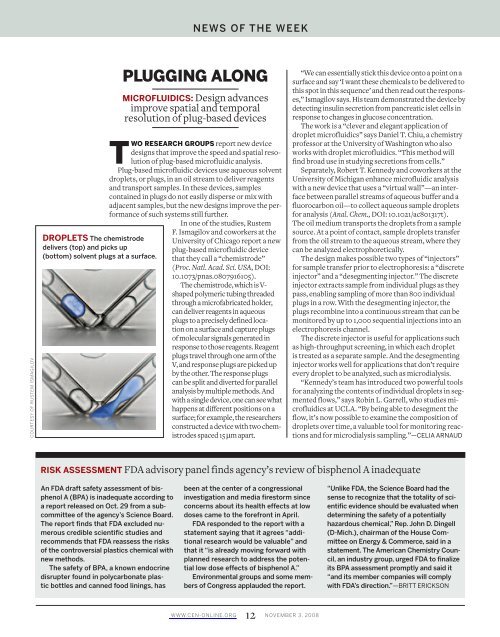Chemical & Engineering News Digital Edition ... - IMM@BUCT
Chemical & Engineering News Digital Edition ... - IMM@BUCT
Chemical & Engineering News Digital Edition ... - IMM@BUCT
Create successful ePaper yourself
Turn your PDF publications into a flip-book with our unique Google optimized e-Paper software.
NEWS OF THE WEEK<br />
COURTESY OF RUSTEM ISMAGILOV<br />
DROPLETS The chemistrode<br />
delivers (top) and picks up<br />
(bottom) solvent plugs at a surface.<br />
PLUGGING ALONG<br />
MICROFLUIDICS: Design advances<br />
improve spatial and temporal<br />
resolution of plug-based devices<br />
TWO RESEARCH GROUPS report new device<br />
designs that improve the speed and spatial resolution<br />
of plug-based microfluidic analysis.<br />
Plug-based microfluidic devices use aqueous solvent<br />
droplets, or plugs, in an oil stream to deliver reagents<br />
and transport samples. In these devices, samples<br />
contained in plugs do not easily disperse or mix with<br />
adjacent samples, but the new designs improve the performance<br />
of such systems still further.<br />
In one of the studies, Rustem<br />
F. Ismagilov and coworkers at the<br />
University of Chicago report a new<br />
plug-based microfluidic device<br />
that they call a “chemistrode”<br />
(Proc. Natl. Acad. Sci. USA, DOI:<br />
10.1073/pnas.0807916105).<br />
The chemistrode, which is V-<br />
shaped polymeric tubing threaded<br />
through a microfabricated holder,<br />
can deliver reagents in aqueous<br />
plugs to a precisely defined location<br />
on a surface and capture plugs<br />
of molecular signals generated in<br />
response to those reagents. Reagent<br />
plugs travel through one arm of the<br />
V, and response plugs are picked up<br />
by the other. The response plugs<br />
can be split and diverted for parallel<br />
analysis by multiple methods. And<br />
with a single device, one can see what<br />
happens at different positions on a<br />
surface; for example, the researchers<br />
constructed a device with two chemistrodes<br />
spaced 15 μm apart.<br />
“We can essentially stick this device onto a point on a<br />
surface and say ‘I want these chemicals to be delivered to<br />
this spot in this sequence’ and then read out the responses,”<br />
Ismagilov says. His team demonstrated the device by<br />
detecting insulin secretion from pancreatic islet cells in<br />
response to changes in glucose concentration.<br />
The work is a “clever and elegant application of<br />
droplet microfluidics” says Daniel T. Chiu, a chemistry<br />
professor at the University of Washington who also<br />
works with droplet microfluidics. “This method will<br />
find broad use in studying secretions from cells.”<br />
Separately, Robert T. Kennedy and coworkers at the<br />
University of Michigan enhance microfluidic analysis<br />
with a new device that uses a “virtual wall”—an interface<br />
between parallel streams of aqueous buffer and a<br />
fluorocarbon oil—to collect aqueous sample droplets<br />
for analysis (Anal. Chem., DOI: 10.1021/ac801317t).<br />
The oil medium transports the droplets from a sample<br />
source. At a point of contact, sample droplets transfer<br />
from the oil stream to the aqueous stream, where they<br />
can be analyzed electrophoretically.<br />
The design makes possible two types of “injectors”<br />
for sample transfer prior to electrophoresis: a “discrete<br />
injector” and a “desegmenting injector.” The discrete<br />
injector extracts sample from individual plugs as they<br />
pass, enabling sampling of more than 800 individual<br />
plugs in a row. With the desegmenting injector, the<br />
plugs recombine into a continuous stream that can be<br />
monitored by up to 1,000 sequential injections into an<br />
electrophoresis channel.<br />
The discrete injector is useful for applications such<br />
as high-throughput screening, in which each droplet<br />
is treated as a separate sample. And the desegmenting<br />
injector works well for applications that don’t require<br />
every droplet to be analyzed, such as microdialysis.<br />
“Kennedy’s team has introduced two powerful tools<br />
for analyzing the contents of individual droplets in segmented<br />
flows,” says Robin L. Garrell, who studies microfluidics<br />
at UCLA. “By being able to desegment the<br />
flow, it’s now possible to examine the composition of<br />
droplets over time, a valuable tool for monitoring reactions<br />
and for microdialysis sampling.”—CELIA ARNAUD<br />
RISK ASSESSMENT FDA advisory panel finds agency’s review of bisphenol A inadequate<br />
An FDA draft safety assessment of bisphenol<br />
A (BPA) is inadequate according to<br />
a report released on Oct. 29 from a subcommittee<br />
of the agency’s Science Board.<br />
The report finds that FDA excluded numerous<br />
credible scientific studies and<br />
recommends that FDA reassess the risks<br />
of the controversial plastics chemical with<br />
new methods.<br />
The safety of BPA, a known endocrine<br />
disrupter found in polycarbonate plastic<br />
bottles and canned food linings, has<br />
been at the center of a congressional<br />
investigation and media firestorm since<br />
concerns about its health effects at low<br />
doses came to the forefront in April.<br />
FDA responded to the report with a<br />
statement saying that it agrees “additional<br />
research would be valuable” and<br />
that it “is already moving forward with<br />
planned research to address the potential<br />
low dose effects of bisphenol A.”<br />
Environmental groups and some members<br />
of Congress applauded the report.<br />
“Unlike FDA, the Science Board had the<br />
sense to recognize that the totality of scientific<br />
evidence should be evaluated when<br />
determining the safety of a potentially<br />
hazardous chemical,” Rep. John D. Dingell<br />
(D-Mich.), chairman of the House Committee<br />
on Energy & Commerce, said in a<br />
statement. The American Chemistry Council,<br />
an industry group, urged FDA to finalize<br />
its BPA assessment promptly and said it<br />
“and its member companies will comply<br />
with FDA’s direction.”—BRITT ERICKSON<br />
WWW.CEN-ONLINE.ORG 12 NOVEMBER 3, 2008

















